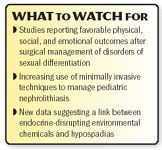Article
Minimally invasive urologic surgery is successful in kids
It appears that ureteroscopy and other minimally invasive techniques, such as laser lithotripsy, are safe and effective in managing pediatric nephrolithiasis, including ureteric calculi, renal pelvic stones, and lower-pole stones.

Key Points

"You can treat most children like young adults and use the same techniques to treat them," said Howard M. Snyder, III, MD, professor of surgery in urology at the University of Pennsylvania, Philadelphia. "That's helpful."
Similarly, forthcoming data show that retroperitoneoscopy and laparoscopic heminephroureterectomy are efficacious for duplication anomalies.
The diagnosis of partial UPJ obstruction and obstructive hydronephrosis continues to be a challenge for clinicians, who must determine whether an obstruction is best approached with surgery or by conservative management. New markers that appear to offer guidance include the frequency of renal jet activity and levels of voided N-acetyl-beta-D-glucosaminidase, alkaline phosphatase, and gamma-glutamyl transferase.
DSD: A contentious issue
It is inevitable that in pediatric urology, as with other medical subspecialties, practitioners disagree on the best way to diagnose and treat particular disease states. But right now, there may be no more contentious issue in the field than how to manage disorders of sexual differentiation (DSD).

Indeed, urologists who operate on children with DSD quite often achieve a satisfactory physical result, but are unsure of how the child will be affected mentally. But according to soon-to-be-released research on the topic, those who undergo feminizing genitoplasty generally maintain good relationships, report satisfactory sexual activity, and maintain vibratory sensibility.
Elsewhere, investigators have found that clitoral regrowth can be prevented by performing complete reduction clitoroplasty with preservation of the neurovascular bundle, and that large dorsal nerve fibers won't necessarily be removed by the procedure.
"It could be that we're doing better with these patients than the critics would suggest," Dr. Snyder said.
Agent for reflux
Dextranomer/hyaluronic acid copolymer (Deflux) continues to carve out a place for itself in the management of pediatric reflux disease. It can be used safely in infants under 2 years of age and in transplanted kidneys, has a highly favorable impact on patients' quality of life, and can be beneficial even for children with functional and anatomic bladder/ureteral anomalies.
However, it is also expensive (nearly $2,800 per patient, by one estimate) and does not appear to prevent de novo contralateral reflux, even when given prophylactically. It also requires the patient to return after 1 year for a cystogram to gauge success.
"We've been saying for quite a while that Deflux could become the treatment of choice for many children with reflux, and it seems we're moving in that direction," Dr. Snyder said.
Trauma management
It is widely recognized that blunt urologic trauma in adults can be managed non-traumatically, and data now suggest that the same is true in children. An upcoming report suggests that CT scans can help determine whether a more aggressive approach is required in these children. Investigators found that early ureteral stenting can be considered in children with multiple extravasation sites or lack of contrast in the ipsilateral ureter on CT scan.




